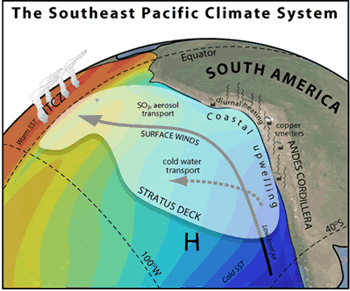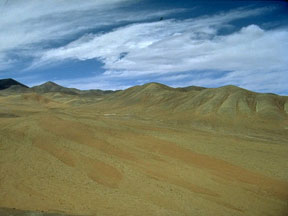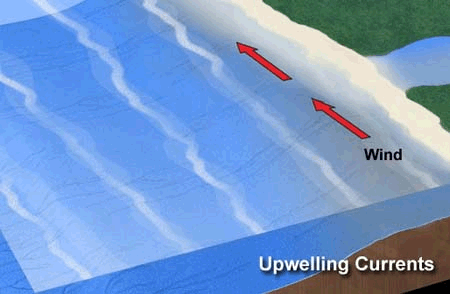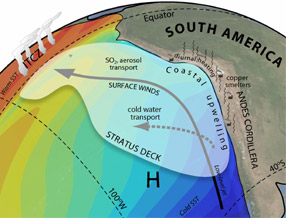Winds along the west coast of South America blow from south to north.
Click on image for full size
Image courtesy of Ron Woods.
Winds in the Southeast Pacific
The winds in the Southeast Pacific mainly blow from south to north. They have a strong effect on the climate in the region and worldwide.
The winds in this area get their start with a major flow in the atmosphere called the Hadley cell. The Hadley cell is formed when warm air rises near the equator and comes back down around 30° South latitude. It then flows back northward towards the equator along the surface. The Coriolis effect turns the winds towards the northwest. These southeast to northwest winds are called the trade winds. The high "wall" of the Andes Mountains helps to steer the winds along the coast and makes them pretty strong. They are sometimes called the "coastal jet".
The air in these winds is very dry. The dry winds help create the Atacama Desert in Chile, which is one of the driest places on Earth. The strong winds also help stir up the ocean. They also help bring cold water from deep in the ocean to the surface. The atmosphere and the ocean in this area are connected in many ways. The strong winds also carry aerosol particles from industries in South America out to sea. The aerosol particles change how clouds form in the area.
The winds in the Southeast Pacific don't just affect the local weather and climate. They also affect climate over a large part of the world. These winds are a big part of the cause of El Niño and La Niña.
You might also be interested in:

Wind is moving air. Warm air rises, and cool air comes in to take its place. This movement creates different pressures in the atmosphere which creates the winds around the globe. Since the Earth spins,
...more
The Southeast Pacific Ocean region off the coastal areas of Peru and Chile is one part of the world where stratus and stratocumulus clouds are frequently present. Other areas include the subtropical climate
...more
The Atacama Desert is one of the driest places on Earth. The Atacama is in the country of Chile in South America. In an average year, much of this desert gets less than 1 millimeter (0.04 inch) of rain!
...more
This page describes environments that are very hot or very cold, extremely dry, or both. Extreme environments are places where "normal" life finds it hard to survive. That doesn't mean that there isn't
...more
There are places in the ocean where water from the deep sea travels up to the surface. These are called areas of upwelling. The deep waters can have a large influence upon life in the ocean and the climate
...more
There are many connections between the ocean and the atmosphere in the Southeast Pacific Ocean. Strong winds blow north along the coast of South America. These winds stir up the ocean. That brings cold
...more
When you look up at the sky, you are looking at more than just air. There are also billions of tiny bits of solid and liquid floating in the atmosphere. Those tiny floating particles are called aerosols
...more














